ASRock Industrial NUC BOX-1360P/D5 Review: Raptor Lake-P on the Leading Edge
by Ganesh T S on July 18, 2023 10:30 AM EST- Posted in
- Systems
- Intel
- UCFF
- Mini-PC
- ASRock Industrial
- Raptor Lake-P
HTPC Credentials
The 2022 Q4 update to our system reviews brings an updated HTPC evaluation suite for systems. After doing away with the evaluation of display refresh rate stability and Netflix streaming evaluation, the local media playback configurations have also seen a revamp. This section details each of the workloads processed on the ASRock NUC BOX-1360P/D5 as part of the HTPC suite.
YouTube Streaming Efficiency
YouTube continues to remain one of the top OTT platforms, primarily due to its free ad-supported tier. Our HTPC test suite update retains YouTube streaming efficiency evaluation as a metric of OTT support in different systems. Mystery Box's Peru 8K HDR 60FPS video is the chosen test sample. On PCs running Windows, it is recommended that HDR streaming videos be viewed using the Microsoft Edge browser after putting the desktop in HDR mode.

YouTube Streaming Statistics - Normal Mode
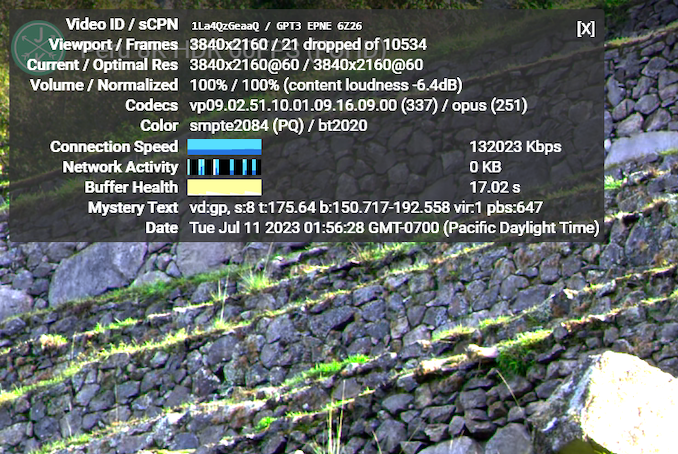
YouTube Streaming Statistics - Performance Mode
The GPU in ASRock NUC BOX-1360P/D5 supports hardware decoding of VP9 Profile 2, and we see the stream encoded with that codec being played back. The streaming is perfect in both the normal and performance modes, thanks to the powerful GPU and hardware decoding support - the few dropped frames observed in the statistics below are due to mouse clicks involved in bringing up the overlay.
The streaming efficiency-related aspects such as GPU usage and at-wall power consumption are also graphed below.

YouTube Streaming Efficiency - Normal Mode

YouTube Streaming Efficiency - Performance Mode
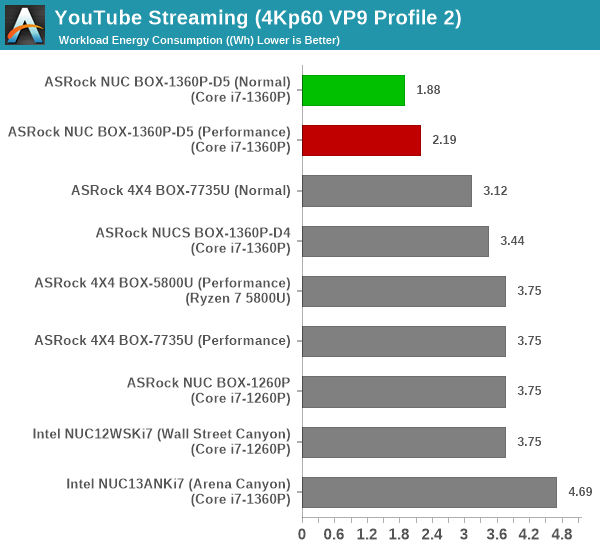
The normal mode configuration is one of the most energy efficient playback segments we have seen in our labs, tying with the Panther Canyon NUC and the Akasa Newton TN. Despite the higher PL1 numbers and constantly running fan, the performance mode is also better off in energy numbers compared to the rest of the considered systems.
Hardware-Accelerated Encoding and Decoding
The transcoding benchmarks in the systems performance section presented results from evaluating the QuickSync encoder within Handbrake's framework. The capabilities of the decoder engine are brought out by DXVAChecker.
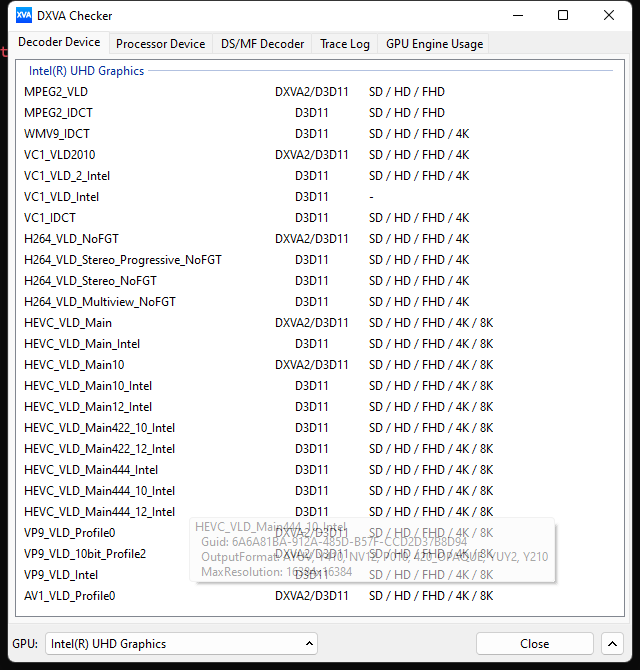
Video Decoding Hardware Acceleration in ASRock NUC BOX-1360P-D5
The iGPU in Raptor Lake-P system supports hardware decode for a variety of codecs including AVC, JPEG, HEVC (8b and 10b, 4:2:0 and 4:4:4), and VP9 (8b and 10b, 4:2:0 and 4:4:4). AV1 decode support is also present. This is currently the most comprehensive codec support seen in the PC space.
Local Media Playback
Evaluation of local media playback and video processing is done by playing back files encompassing a range of relevant codecs, containers, resolutions, and frame rates. A note of the efficiency is also made by tracking GPU usage and power consumption of the system at the wall. Users have their own preference for the playback software / decoder / renderer, and our aim is to have numbers representative of commonly encountered scenarios. Our Q4 2022 test suite update replaces MPC-HC (in LAV filters / madVR modes) with mpv. In addition to being cross-platform and open-source, the player allows easy control via the command-line to enable different shader-based post-processing algorithms. From a benchmarking perspective, the more attractive aspect is the real-time reporting of dropped frames in an easily parseable manner. The players / configurations considered in this subsection include:
- VLC 3.0.18
- Kodi 20.2
- mpv 0.35.1 (hwdec auto, vo=gpu-next)
- mpv 0.35.1 (hwdec auto, vo=gpu-next, profile=gpu-hq)
Fourteen test streams (each of 90s duration) were played back from the local disk with an interval of 30 seconds in-between. Various metrics including GPU usage, at-wall power consumption, and total energy consumption were recorded during the course of this playback.
All our playback tests were done with the desktop HDR setting turned on. It is possible for certain system configurations to automatically turn on/off the HDR capabilities prior to the playback of a HDR video, but, we didn't take advantage of that in our testing.
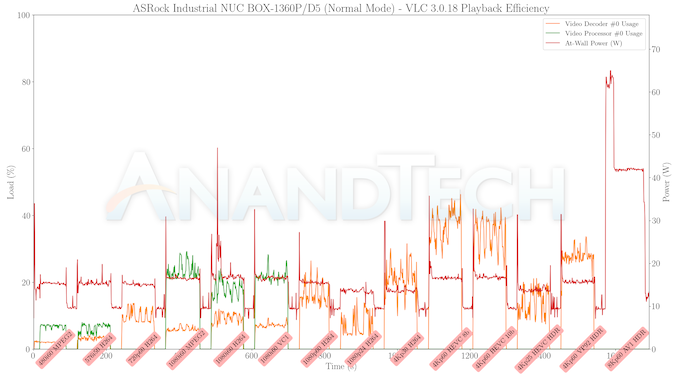
VLC Playback Efficiency - Normal Mode
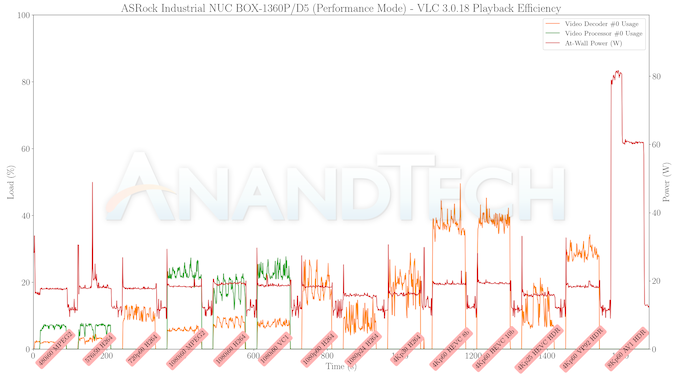
VLC Playback Efficiency - Performance Mode
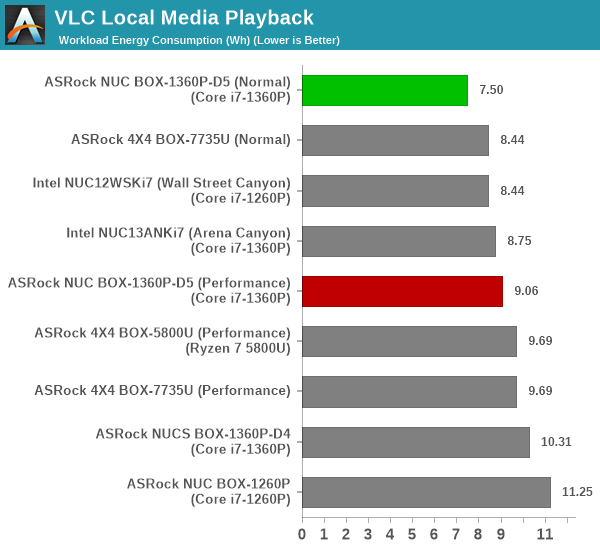
The 8Kp60 AV1 stream playback is attempted in software, resulting in extremely high power consumption at the wall (80+ W). Otherwise, at-wall numbers remain below 20W for VLC playback, with the normal mode configuration being particularly energy efficient.

Kodi Playback Efficiency - Normal Mode

Kodi Playback Efficiency - Performance Mode

Similar to VLC, the 8Kp60 AV1 clip is problematic for Kodi 20.2. However, active power consumption is lower for Kodi compared to VLC. Kodi, at idle, does consume more power than just leaving the desktop idle. So, the energ numbers for Kodi are not great compared to VLC. However, within the considered systems, Kodi was more energy-efficient on the normal mode NUC BOX-1360P/D5.

mpv 0.35.1 Playback Efficiency - Normal Mode
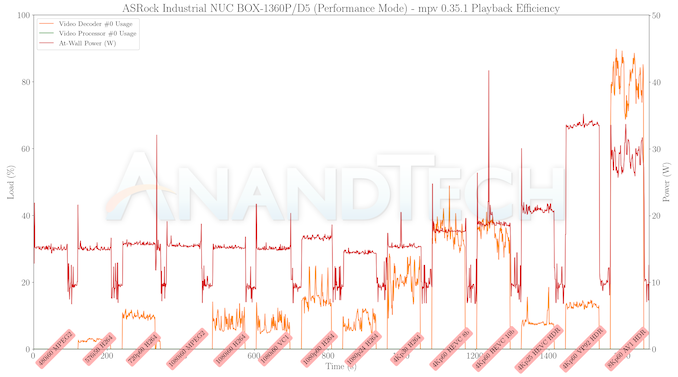
mpv 0.35.1 Playback Efficiency - Performance Mode

mpv attempts to play back the 8Kp60 AV1 clip with hardware acceleration, but the playback still dropped half the frames (same symptom we have been observing in all recent mini-PC reviews). Active power numbers are much higher than Kodi or VLC.
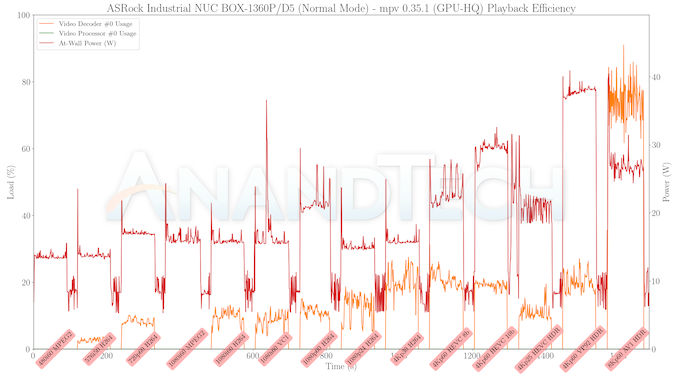
mpv 0.35.1 (GPU-HQ) Playback Efficiency - Normal Mode
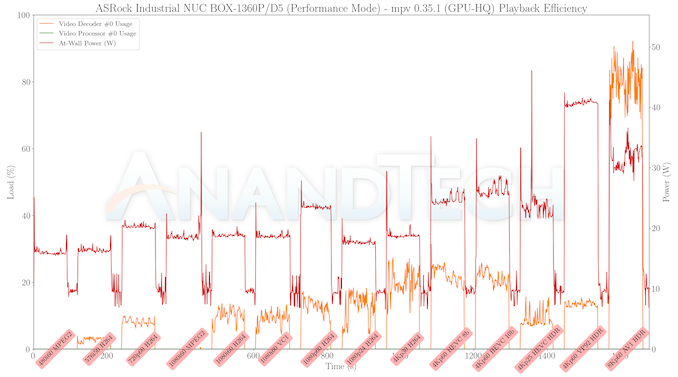
mpv 0.35.1 (GPU-HQ) Playback Efficiency - Performance Mode

Adding GPU-HQ shaders to the mix drives up the energy consumption numbers for all systems, with the Wall Street Canyon becoming the most efficient of the lot. Surprisingly, only the AV1 clip continued to drop frames during playback.










21 Comments
View All Comments
ganeshts - Wednesday, July 19, 2023 - link
Any links to such a 'NUC' ?I do have a Phoenix-based GTR7 from Beelink here in my testbed, but driver issues are preventing it from completing our benchmark suite. I am waiting for a new driver release from AMD.
lemurbutton - Friday, July 21, 2023 - link
And any M2 Mac Mini would destroy any Zen4 NUC.TheinsanegamerN - Monday, July 24, 2023 - link
Until you have to run something not in the MAC ecosystem. OOPS!PeachNCream - Friday, July 21, 2023 - link
I don't think destruction is quite the right to articulate your apparent thoughts. Perhaps "result in higher scores on benchmarks" or maybe "complete compute workloads sooner" would fit better in this case. Computer nerds appear to be rather detached from reality when expressing thoughts which gives all of them a bad reputation among the better positioned and more intelligent normal population.Samus - Saturday, July 22, 2023 - link
The problem with AMD enterprise and industrial products has always been management adoption. Intel has IT depts hooked on vPro, iME, AMT, etc.nicolaim - Wednesday, July 19, 2023 - link
It's 2023. Only two USB-C ports, none on the back.Samus - Thursday, July 20, 2023 - link
That was my gripe. Replace the HDMI and DP ports with two TB4-compliant USB-C ports on the rear would be the minimum modification for such an 'industrial' appliance. Seriously, why do you have to plug something into the front to use Thunderbolt?PeachNCream - Thursday, July 20, 2023 - link
Probably because nobody uses or cares about Thunderbolt. Sure it has that usual small, insane rabid fanbase that any obscure computer standard had in the past, but outside of the inevitable idiots that inflate its utility, no one cares and no one profits from it.abufrejoval - Monday, July 24, 2023 - link
That's a bit harsh.Yes, using TB to its full potential is somewhat expensive but given a choice, I'll always opt for the TB variant over pure USB, if only for 10Gbit Ethernet.
Front vs. back: I guess they have done their studies on how people use TB and unfortunately habits vary between people.
Most of my dual TB systems have one TB in the front, the other in the back and that works pretty well for me. The 10GBase-T NIC goes into the back port and the front port is open to anything transient, which could be just some USB media (these native SATA 10Gbit USB sticks are hard to beat via anything native TB), a temporary display (Alt-DP handy there) and in theory to things like TB networking, which is typically transient.
The older systems just have a single TB and expect a hub connected on the back, which seems sensible.
Two in the front and two in the back would be better still, even if you couldn't use all four at full speed for lack of PCIe lanes or a cheap enough switch.
Yet again, when your NUC is stuck to the back of a display, who cares what's front or back, because it's all behind the screen anyway and it's only people like me, wo use clusters of these NUCs as µ-servers in a "tiny-rack" who get bothered by the orientation of those ports.
Changing port orientation in a NUC means a mainboard redesign and few would want to pay for that. So I guess their asked their volume customers and this is what those came up with.
Very few vendors want to aggravate the customers.
sjkpublic@gmail.com - Thursday, July 20, 2023 - link
Performance comparison says it all. 1360P DOA. 7735U $100-200 cheaper for ASROCK. Even cheaper if you look at other companies.